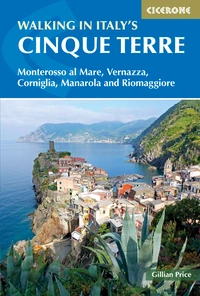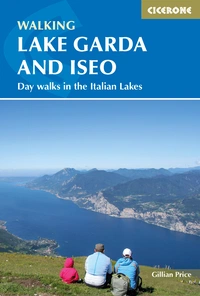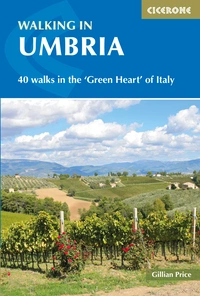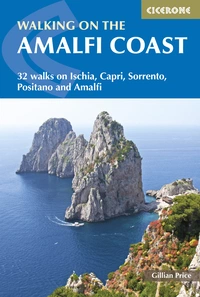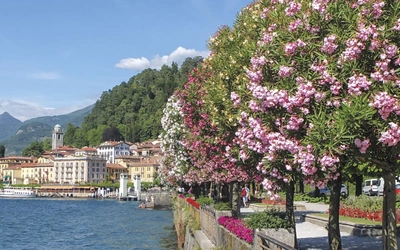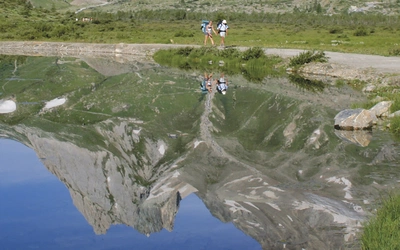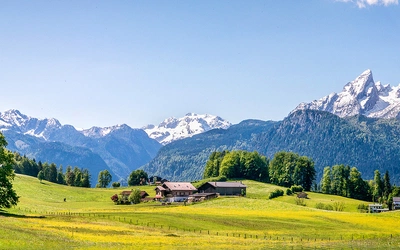The Cinque Terre – essential facts & top tips
Pastel-coloured villages cling to dizzying rock promontories above the sparkling sea, seemingly defying gravity. Man-made terraces cascade down steep mountainsides, and neck-craning paths lead to breathtaking lookouts. Secluded coves with turquoise waters reward those who brave the knee-challenging stone steps. Mediterranean wildflowers and superb cuisine, featuring locally grown olives and wine, add to the charm. This is Liguria's Cinque Terre, a UNESCO World Heritage Site. Here, we answer visitors' frequently asked questions about this magical place.
Walking in Italy's Cinque Terre
Monterosso al Mare, Vernazza, Corniglia, Manarola and Riomaggiore
£17.95
Guidebook to walking Italy's stunning Cinque Terre. Describes 16 routes in and around the five famous fishing villages of Monterosso, Vernazza, Corniglia, Manarola and Riomaggiore. Breathtakingly beautiful, this UNESCO World Heritage coastline is a walker's (and foodie's) dream destination.
More informationWhat are the Cinque Terre?
They are five villages – Monterosso, Vernazza, Corniglia, Manarola and Riomaggiore – strung along a spectacular near-vertical rocky coastline in northwest Italy. This is the Liguria region and we're talking about a mere 12km stretch between the towns of La Spezia and Genoa.
What's so special about the Cinque Terre?
The villages are a photogenic jumble of tiny, medieval tower-like houses perched on rocky terrain, often just a wave's spray from the sea. Flights of steps and steep alleys lead to higher buildings on headlands. Historically, communication was by boat and a network of mule tracks linking inhabitants to their fields. These "fields" are tiny plots, painstakingly terraced over centuries, supported by dry stone walls. Cascading down slopes, they form the breathtaking landscape of Cinque Terre. For walkers, marked routes follow these ancient trails, passing grapevines, olive groves, and vegetable plots.
How do I get to the Cinque Terre?
Getting to the Cinque Terre is easy—just take the train. From the south and Tuscany (via Pisa's international airport), the naval port city of La Spezia is your gateway. From the north, you'll pass through Genoa before reaching the key station of Levanto. Fast trains between Genoa and Pisa skip most Cinque Terre stations, so it's best to catch the local all-stops Cinque Terre Express between Levanto and La Spezia, which runs every half hour from spring to autumn and hourly the rest of the year. Train timetables are available at trenitalia.com.
To travel between the Cinque Terre villages, a good ferry service operates from spring to autumn. Additionally, the Explora bus runs between La Spezia and some villages.
While there are roads to each village, they are narrow, steep, traffic-restricted, and mainly for residents and deliveries. Car parks are limited and expensive. Bottom line: visitors should not plan on arriving by car.
Where accommodation options are available in the Cinque Terre?
The Cinque Terre area is not huge and any one of the villages makes a handy walking base thanks to the excellent train and local bus services. Hotels as such are few and far between due to space restrictions. However there is a wonderful range of accommodation for all pockets. Hostels with shared dormitories and separate rooms can be found in Levanto, Manarola and Porto Venere, otherwise there are countless B&Bs and apartments for rent everywhere. Accommodation is best booked well ahead in high season – namely May and September, as well as Italian public holidays. Camping is not allowed anywhere.
Hint: bring as little as possible as rooms are small and you’ll inevitably have to drag your bags up and down steep flights of steps yourself – lifts are unheard of. Most railway stations have left luggage facilities.
Do I need to book to walk the famous Via dell'Amore?
Booking path access is never necessary however this route (which links Manarola and Riomaggiore) is currently closed as it is being reconstructed after storm damage. The Cinque Terre Park website gives up-to-date info about paths.
Is there a charge to use the paths?
The only route subject to a fee is the Sentiero Verde Azzurro – SVA – which links all five villages. However, at present only two sections are accessible. In any case you can buy a day pass at the ticket booth where the walk starts. The Cinque Terre Park uses the proceeds for path maintenance. Multi-day passes including train travel, WC and local shuttle buses are also available. See the Cinque Terre Park website.
Are all the Cinque Terre walks day routes? Are there any multi-day treks?
While most of the routes in Walking Italy's Cinque Terre are day walks, you can easily put together a superbly rewarding traverse by stringing together six of them. Trek from Levanto all the way over to Porto Venere on the Gulf of La Spezia in 3–4 days. Along the way you stay in a different village each night and get a wonderful idea of the Cinque Terre as a whole.
I've heard it's difficult to carry luggage into the villages. What's the best option?
Carry as little as possible as you'll be the one lugging your bags up and down gravity-defying flights of steps and squeezing along alleyways on the way to your accommodation. Lifts are virtually unheard of. Most railway stations have left luggage facilities so, needs be, you can leave excess stuff there.
What if the path I've chosen is closed?
Choose another one. Under no circumstances should anyone venture onto a path that has been closed by the local authorities.
You are putting your own life and those of the emergency services at risk if you need rescuing. The local authorities take risk very seriously – as should all visitors. In the aftermath of strong storms and heavy rain paths are often closed off – sometimes as a precaution as rockfall and landslides are a constant threat. Fire danger in high summer is another reason. All closures are listed on the Cinque Terre Park website.
Is it OK to walk in sandals?
The terrain is uneven and rocky and you need footwear with good grip and some ankle support. Lightweight walking boots are the best bet, although quality sports shoes will be OK.
Will I need trekking poles?
This depends on knees and individual preferences, but I can personally guarantee that if you take a pair of trekking poles with you to the Cinque Terre you won't regret it. Level terrain is unheard of, gradients tend to be steep and never-ending flights of stone steps appear out of nowhere.
Are there any quiet walking routes?
You bet there are! Several jaw-dropping (and knee-challenging) paths can be found in the southernmost section near the mountain hamlet of Campiglia, including the spectacular stone stepped way down to Monesteroli.
What are the area's highlights?
In addition to the five principal villages which come under the protection of the Parco Nazionale Cinque Terre this guidebook includes neighbouring settlements that offer worthwhile pathways. These are seafront Levanto in the north, mountainside Campiglia further down, then charming Porto Venere at the southern extremity on the opening of the Gulf of La Spezia. Each place has a distinct character and for different reasons makes a great base for a walking holiday. All are easily accessible by public transport, and have tourist and park info offices, ATM cash points, as well as grocery shops, cafés and restaurants, and masses of accommodation. The sole exception is Campiglia which has no info office or ATM.
Starting in the north west, Levanto is a natural entry gate to the Cinque Terre for visitors arriving by rail from the Ligurian regional capital of Genoa. The no-frills town has plenty of advantages, ranging from easy access, lower prices and a decent beach, though it is rather lacking in charm. Walk 1 starts its marvellous traverse here.
Separated from Levanto and the rest of the world by a high ridge culminating in the rugged headland of Punta Mesco, spread-out Monterosso al Mare (with a population of 1468) is the only one of the Cinque Terre to boast a beach worthy of that name – an inviting expanse of golden sand stretching along an ample bay. As well as a fair amount of level land, Monterosso has roads and a modern section called Fegina with a batch of hotels, not to mention a railway station. A pleasant seafront promenade runs through a road tunnel to the old centro storico, passing a watchtower occupying a rocky point.
Next along is superbly photogenic Vernazza snuggling in a secluded cove. A modest pocket of sand and harbour protected by breakwaters is overlooked by the elegant Romanesque church of Santa Margherita d’Antiochia. A delightful place to stay, Vernazza has 852 permanent inhabitants and a railway station carved into the hillside.
The middle village of the five, charming Corniglia is by far the quietest thanks to its elevated position perched on a vertiginous clifftop headland. This may explain the origin of its name from ‘corno’ rocky spur. From the railway station you go up the famous Scalinata Lardarina, a zigzagging brick stairway composed of 382 steps and 33 ramps – though there’s also a bus run via the road. In addition to elegant churches and cosy houses, it boasts a belvedere terrace for legendary sunsets over the Ligurian Sea.
The following stop is beautiful Manarola. Here a divine sheltered bay and harbour are popular with swimmers who clamber up rock pinnacles to dive into the clear blue sea. The houses here are squeezed into a narrow valley, leaving plenty of space for the extensive terraced vineyards above. The name may derive from magna rota, the large wheel of the water-driven mill that can still be seen in the main street – a convincing explanation as a river crossed by 11 stone bridges flowed here until the 1950–1970s when it was paved over. Another mammoth task was the long pedestrian tunnel that burrows under a cliff connecting the railway station.
The last of the Cinque Terre is lively Riomaggiore. According to local hearsay it was founded by eighth century Greeks fleeing persecution in their homeland. The name derives from the Rivus Major watercourse, now hidden away beneath tarmac. Over time Riomaggiore grew into a sizeable village, typical narrow alleys lined with tower-like buildings piled on top of each other and looked over by a humble castle; the last census gave a population of 1542. The seafront is an especially celebrated spot of an evening when the orange rays of the setting sun light up the coloured houses that appear to topple off the cliffs.
Perched at 400m altitude on a panoramic saddle boasting marvellous views looking both to the Gulf of La Spezia and over the Ligurian Sea, laidback Campiglia sees few visitors. With a permanent population of 60 that swells during the summer months, the mountainside hamlet is an inviting spot and is the start for walks that visit secluded coves. It has a good bus service to La Spezia and also offers groceries, a handful of restaurants and accommodation.
Walking in Italy's Cinque Terre
Monterosso al Mare, Vernazza, Corniglia, Manarola and Riomaggiore
£17.95
Guidebook to walking Italy's stunning Cinque Terre. Describes 16 routes in and around the five famous fishing villages of Monterosso, Vernazza, Corniglia, Manarola and Riomaggiore. Breathtakingly beautiful, this UNESCO World Heritage coastline is a walker's (and foodie's) dream destination.
More information
